Scuba diving locations offer a glimpse into the wonders of the underwater world, from vibrant coral reefs teeming with marine life to historic shipwrecks and mysterious underwater caves. Whether you’re a seasoned diver or just starting out, choosing the right destination is crucial for an unforgettable experience.
Factors to consider when selecting a scuba diving location include water clarity, marine life diversity, accessibility, and the availability of dive sites that cater to your interests and skill level. From the crystal-clear waters of the Caribbean to the enigmatic depths of the Pacific, there are countless destinations waiting to be explored.
Overview of Scuba Diving Locations
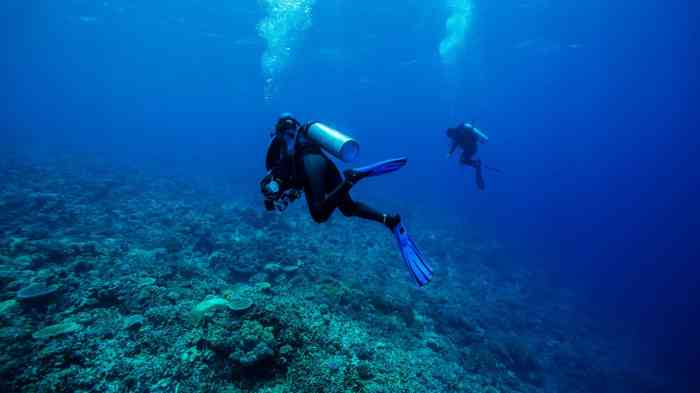
Scuba diving is an underwater sport that involves the use of scuba gear to explore the underwater world. It is a popular activity among adventure enthusiasts, nature lovers, and photographers, offering a unique opportunity to observe marine life up close and experience the beauty of the underwater environment.
When choosing a scuba diving location, several factors need to be considered, including water clarity, marine life diversity, and accessibility. Water clarity refers to the visibility underwater, which is influenced by factors such as sunlight, plankton concentration, and sediment levels. Marine life diversity refers to the variety of marine species found in the area, including fish, corals, and other aquatic organisms. Accessibility refers to the ease of reaching the dive site, including factors such as distance from shore, depth of the water, and availability of dive operators.
Water Clarity
Water clarity is an important factor to consider when choosing a scuba diving location, as it affects the visibility underwater. Good water clarity allows divers to see farther and observe marine life more easily. Factors that affect water clarity include sunlight, plankton concentration, and sediment levels.
Marine Life Diversity
Marine life diversity refers to the variety of marine species found in a particular area. This can include fish, corals, and other aquatic organisms. Dive sites with high marine life diversity offer divers the opportunity to observe a wide range of species and experience the beauty of the underwater ecosystem.
Accessibility
Accessibility refers to the ease of reaching a dive site. This can include factors such as distance from shore, depth of the water, and availability of dive operators. Dive sites that are easily accessible are more convenient for divers, while those that are more remote may require additional planning and effort to reach.
Top Scuba Diving Destinations: Scuba Diving Locations
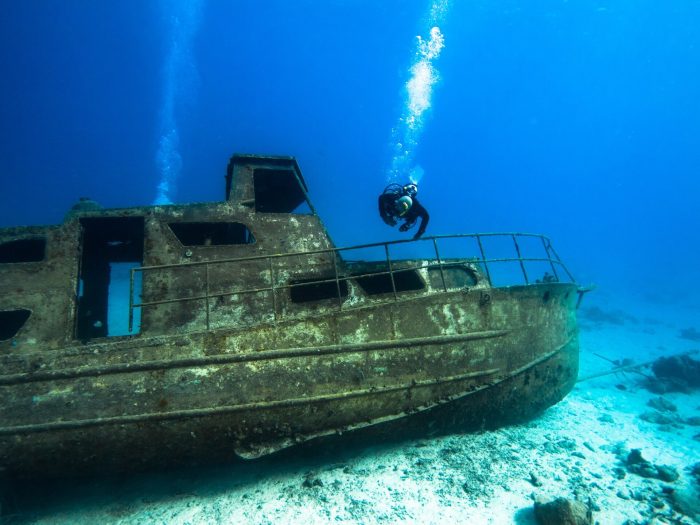
The world’s oceans are home to a vast array of scuba diving destinations, each offering unique experiences and underwater wonders. From vibrant coral reefs to historic shipwrecks, there are countless places to explore beneath the waves.
For those seeking extraordinary scuba diving experiences, the Caribbean offers a myriad of captivating destinations. From the vibrant coral reefs of Belize to the enigmatic underwater cenotes of Mexico, the region boasts an array of marine wonders. Yet, beyond its allure for divers, the Caribbean is also renowned for its pristine beaches.
For a blissful blend of underwater exploration and sun-kissed relaxation, consider exploring the best beaches in the Caribbean. From the sugary sands of Jamaica to the turquoise waters of the Dominican Republic, these idyllic shores offer a perfect complement to your scuba diving adventures.
To help you plan your next scuba diving adventure, we’ve compiled a list of the top scuba diving destinations worldwide. These destinations offer a diverse range of dive sites, from beginner-friendly shallow reefs to challenging deep walls and wrecks.
Top Scuba Diving Destinations Worldwide
| Destination | Location | Key Features | Recommended Dive Sites |
|---|---|---|---|
| Great Barrier Reef | Australia | World’s largest coral reef system, home to over 1,500 species of fish | Lady Elliot Island, Cod Hole, Agincourt Reef |
| Maldives | Indian Ocean | Over 1,000 coral islands and atolls, known for crystal-clear waters and abundant marine life | Banana Reef, Manta Point, Maaya Thila |
| Cozumel | Mexico | World’s second-largest barrier reef, with steep walls, coral gardens, and a variety of marine life | Palatuluc Reef, Santa Rosa Wall, Paradise Reef |
| Galapagos Islands | Ecuador | Unique ecosystem with a wide range of marine life, including sea lions, penguins, and hammerhead sharks | Darwin’s Arch, Wolf Island, Gordon Rocks |
Types of Scuba Diving Sites
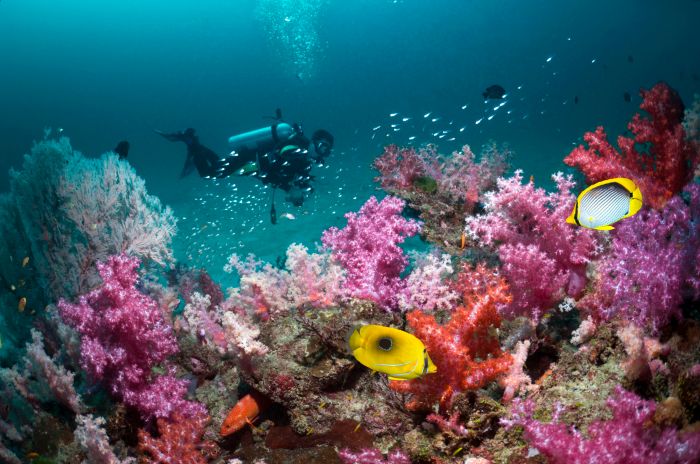
Scuba diving offers a wide range of experiences, with different types of sites catering to various preferences and skill levels. From vibrant coral reefs teeming with marine life to awe-inspiring wrecks and mysterious underwater caves, each type of site presents unique characteristics and attractions.
Coral Reefs
Coral reefs are among the most popular scuba diving destinations, renowned for their stunning biodiversity and vibrant colors. These underwater ecosystems are home to a myriad of marine creatures, including fish, invertebrates, and sea turtles. Coral reefs provide a vital habitat for many species and offer divers an unforgettable experience of exploring their intricate structures and diverse inhabitants.
Wrecks
Scuba diving on wrecks offers a glimpse into maritime history and provides an eerie and awe-inspiring experience. Sunken ships, from ancient galleons to modern vessels, create artificial reefs that attract a variety of marine life. Exploring wrecks requires specialized training and experience, but it rewards divers with the opportunity to uncover the secrets of these submerged vessels and witness the unique ecosystems they support.
Underwater Caves
Underwater caves offer a challenging and rewarding experience for experienced divers. These subterranean labyrinths require specialized equipment and training, but they reveal a hidden world of crystal-clear waters, intricate rock formations, and often unique species adapted to the cave environment. Exploring underwater caves provides a thrilling adventure for divers seeking an unforgettable experience.
Marine Life Encounters

Scuba diving offers an unparalleled opportunity to encounter a diverse array of marine life in their natural habitat. From vibrant coral reefs teeming with fish to majestic sea turtles and awe-inspiring sharks, the underwater world is a captivating tapestry of life.
Divers must prioritize the well-being of marine life by adhering to responsible diving practices. Avoid touching or harassing animals, maintain a respectful distance, and refrain from feeding them. Your actions can significantly impact the delicate marine ecosystem.
Fish Species
Coral reefs are vibrant underwater cities, home to an astonishing variety of fish species. From the tiny neon goby to the massive whale shark, each species plays a vital role in maintaining the reef’s health.
- Angelfish: With their vibrant colors and flowing fins, angelfish are a popular sight on reefs. Their diet includes sponges, tunicates, and small invertebrates.
- Clownfish: These small, colorful fish are famous for their symbiotic relationship with anemones, which provide them with protection from predators.
- Wrasse: Wrasses are a diverse group of fish with various colors and patterns. They feed on a wide range of invertebrates, including mollusks, crustaceans, and worms.
Sea Turtles
Sea turtles are ancient mariners that have inhabited the oceans for millions of years. These gentle giants are often encountered by divers in tropical and subtropical waters.
- Green Sea Turtle: The largest of the sea turtles, green turtles are herbivores that feed primarily on seagrass. They are listed as endangered due to habitat loss and hunting.
- Hawksbill Sea Turtle: Hawksbills are known for their distinctive beak-like mouths, which they use to feed on sponges. They are critically endangered due to poaching for their beautiful shells.
- Loggerhead Sea Turtle: Loggerheads are powerful predators that feed on jellyfish, fish, and crustaceans. They are listed as threatened due to habitat loss and entanglement in fishing gear.
Sharks, Scuba diving locations
Sharks are often misunderstood creatures that play a crucial role in maintaining marine ecosystems. While some species can be dangerous, most sharks are not aggressive towards humans.
- Whale Shark: The largest fish in the world, whale sharks are filter feeders that feed on plankton. They are gentle giants that can grow up to 40 feet long.
- Great White Shark: One of the most iconic predators in the ocean, great white sharks are known for their powerful jaws and sharp teeth. They primarily feed on seals and sea lions.
- Tiger Shark: Tiger sharks are opportunistic predators with a diverse diet that includes fish, sea turtles, and even other sharks. They are known for their aggressive behavior and are often feared by divers.
Rays
Rays are fascinating creatures that glide through the water with grace and elegance. They are closely related to sharks but have flattened bodies and enlarged pectoral fins.
- Manta Ray: These majestic rays can have wingspans of up to 20 feet. They feed on plankton and are known for their playful behavior.
- Stingray: Stingrays have venomous barbs on their tails that they use for defense. They typically bury themselves in the sand and ambush their prey.
- Eagle Ray: Eagle rays have long, pointed wings that give them the appearance of flying through the water. They feed on fish, crustaceans, and mollusks.
Planning a Scuba Diving Trip

Planning a scuba diving trip can be an exciting and rewarding experience, but it’s essential to do your research and prepare adequately to ensure a safe and enjoyable adventure.
Scuba diving enthusiasts are always on the lookout for the best locations to explore the underwater world. The Caribbean region is renowned for its crystal-clear waters and diverse marine life. In addition to its world-class scuba diving spots, the Caribbean is also home to some of the best beaches in the world.
Whether you’re a seasoned diver or just starting out, the Caribbean offers a wide range of options to suit your needs.
Choosing a Destination
The first step in planning a scuba diving trip is choosing a destination. Consider your interests, experience level, and budget when selecting a location. Research different dive sites to find one that offers the type of diving you’re interested in, whether it’s wreck diving, reef diving, or marine life encounters.
Booking Accommodations
Once you’ve chosen a destination, book your accommodations. Look for hotels or resorts that cater to scuba divers and offer amenities such as dive lockers, gear storage, and boat transportation to dive sites.
Arranging Dive Tours
Most scuba diving destinations offer dive tours led by experienced dive operators. These tours typically include boat transportation to dive sites, dive equipment rentals, and guided dives with a divemaster or instructor. Book your dive tours in advance to secure your spot, especially if you’re traveling during peak season.
Essential Gear and Equipment
Scuba diving requires specialized gear and equipment to ensure safety and comfort underwater. The essential gear includes:
- Buoyancy Compensator Device (BCD): Provides buoyancy and helps control your depth underwater.
- Regulator: Delivers air from the scuba tank to your mouth.
- Dive Computer: Monitors depth, time, and air pressure.
- Scuba Tank: Holds compressed air for breathing underwater.
- Dive Mask: Provides clear vision underwater.
- Snorkel: Allows you to breathe on the surface without removing your regulator.
- Fins: Propels you through the water.
- Wetsuit or Drysuit: Provides warmth and protection underwater.
It’s important to ensure that your gear is properly fitted and maintained before your dive. You can rent gear at most dive destinations, but it’s often more convenient and cost-effective to bring your own.
Safety Considerations
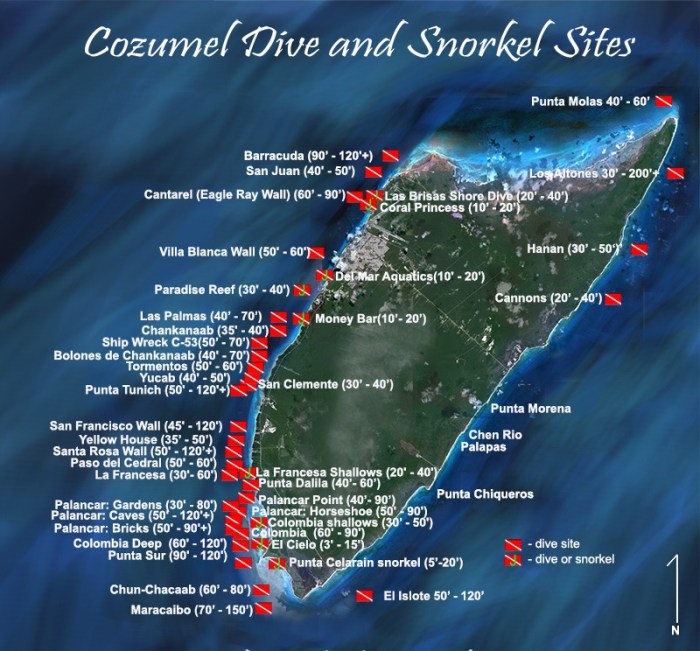
Scuba diving is an exciting and rewarding activity, but it’s crucial to prioritize safety. Diving involves inherent risks and hazards, and it’s essential to be aware of them and take appropriate precautions to minimize potential dangers.
Understanding the potential risks and hazards is the first step towards ensuring safety. These may include decompression sickness, nitrogen narcosis, equipment malfunctions, and marine life encounters. By being aware of these risks, divers can take steps to prevent or mitigate them.
Equipment Maintenance and Inspection
Regular maintenance and inspection of scuba diving equipment are vital for safety. Divers should ensure their gear is in good working order before each dive. This includes checking the regulator, buoyancy compensator device (BCD), dive computer, and other critical components.
Exploring the depths of the ocean can be an unforgettable experience for families, but finding affordable scuba diving locations can be a challenge. Consider planning a budget family vacation to destinations like the Caribbean or Southeast Asia, where affordable scuba diving options abound.
These locations offer pristine waters, vibrant marine life, and budget-friendly accommodations, making it possible for families to experience the wonders of the underwater world without breaking the bank.
- Inspect hoses and connections for any signs of wear or damage.
- Check the regulator for proper breathing resistance and any leaks.
- Test the BCD for proper inflation and deflation.
- Verify the dive computer’s functionality, including battery life and depth gauge accuracy.
Buddy System
Diving with a buddy is essential for safety. Divers should always have a partner to monitor their well-being and provide assistance in case of an emergency. Buddies should stay within sight of each other and communicate regularly.
Training and Certification
Proper training and certification are crucial for safe scuba diving. Divers should receive instruction from a certified instructor and obtain the necessary certification level for their diving experience and intended dive sites.
Training covers essential skills such as dive planning, buoyancy control, emergency procedures, and marine life identification.
Dive Planning
Thorough dive planning is essential for a safe and enjoyable dive. Divers should research the dive site, check weather conditions, and plan their dive profile, including depth, duration, and decompression stops.
It’s also important to consider factors such as currents, visibility, and marine life in the area.
Emergency Procedures
Divers should be familiar with emergency procedures, including how to respond to equipment failures, lost buddies, and decompression sickness. It’s recommended to carry an emergency whistle or other signaling device.
By adhering to these safety considerations, divers can minimize the risks associated with scuba diving and ensure a safe and enjoyable experience.
Certification and Training

To ensure a safe and enjoyable scuba diving experience, obtaining the proper certification and training is crucial. Various levels of scuba diving certifications are available, each requiring specific training to obtain them.
Acquiring a scuba diving certification offers numerous benefits, including:
- Demonstrates your competency and knowledge to potential dive operators.
- Provides a standardized framework for divers to follow, ensuring safety and responsible diving practices.
- Enhances your diving skills and confidence, allowing you to explore more challenging dive sites.
- Opens up opportunities for specialized diving activities, such as wreck diving or underwater photography.
Certification Levels
The most recognized scuba diving certification agency is the Professional Association of Diving Instructors (PADI). PADI offers a range of certification levels, from beginner to professional:
- Open Water Diver: The entry-level certification, covering basic scuba diving skills and knowledge.
- Advanced Open Water Diver: Enhances your diving skills with additional training in specific areas, such as deep diving or underwater navigation.
- Rescue Diver: Teaches you how to respond to diving emergencies and assist other divers in need.
- Divemaster: Provides you with the skills to supervise and assist certified divers during dives.
- Assistant Instructor: Qualifies you to assist instructors in teaching scuba diving courses.
- Open Water Scuba Instructor: Allows you to independently teach scuba diving courses and certify new divers.
The training required for each certification level varies in duration and intensity. Typically, it involves a combination of classroom sessions, pool training, and open water dives. The specific requirements may differ depending on the certification agency and the instructor.
Closing Notes
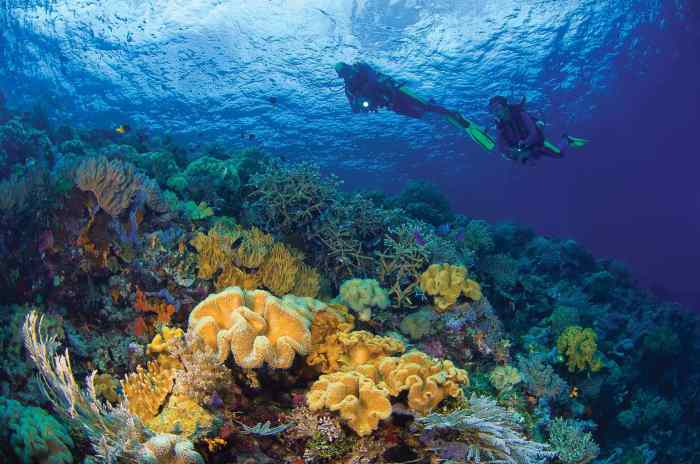
Scuba diving offers a unique opportunity to connect with nature and witness the beauty and diversity of the underwater world. By choosing the right location and following responsible diving practices, you can create memories that will last a lifetime.
Questions Often Asked
What are the most popular scuba diving destinations?
Some of the most popular scuba diving destinations include the Great Barrier Reef, the Maldives, the Galapagos Islands, and the Red Sea.
What types of marine life can I see while scuba diving?
You can see a wide variety of marine life while scuba diving, including fish, sea turtles, sharks, rays, and dolphins.
What are the safety considerations for scuba diving?
Scuba diving is a safe activity, but there are some safety considerations to keep in mind, such as staying within your limits, diving with a buddy, and getting proper training.